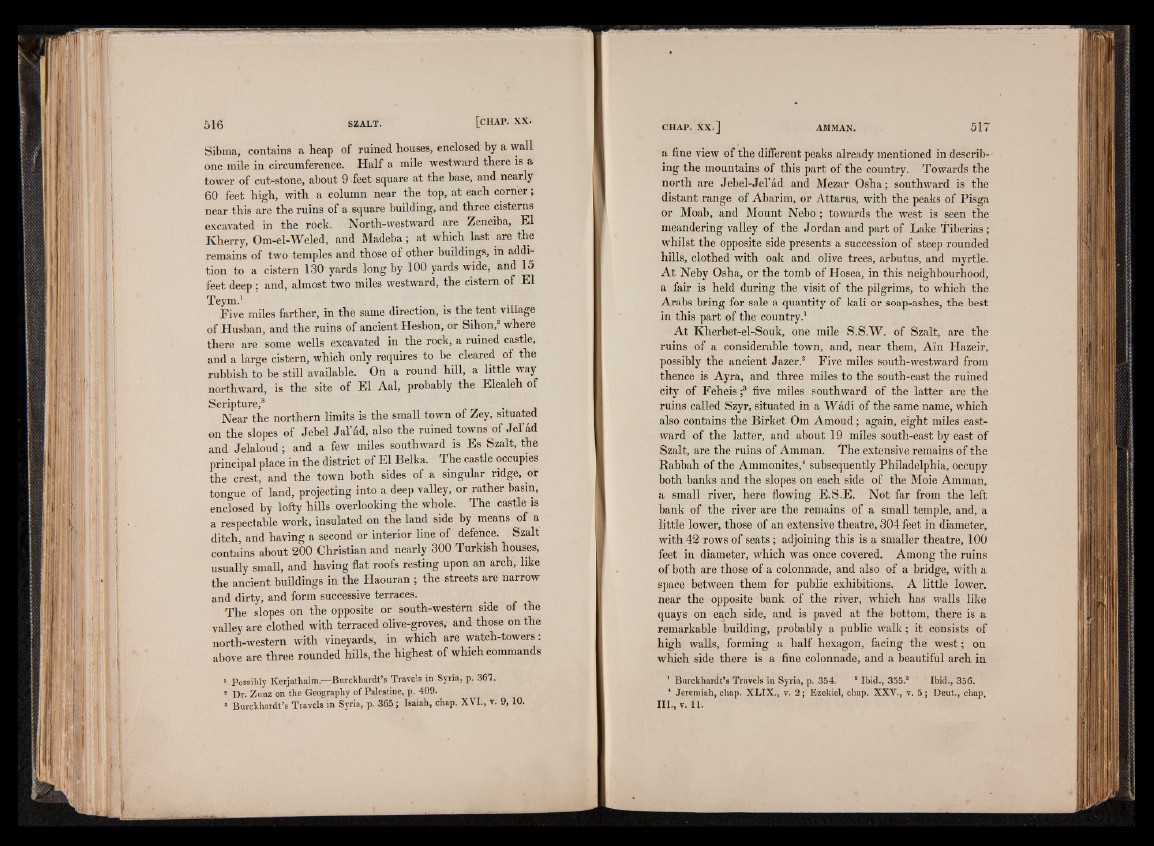
Sibma, contains a heap of ruined houses, enclosed by a wall
one mile in circumference. Half a mile westward there is a
tower of cut-stone, about 9 .feet square at the base, and nearly
60 feet high, with a column near the top, at each corner;
near this are the ruins of a square building, and three cisterns
excavated in the rock. North-westward are Zeneiba, El
Kherry, Om-el-Weled, and Madeba; at which last are the
remains of two temples and those of other buildings, in addition
to a cistern 130 yards long by 100 yards wide, and 15
feet deep ; and, almost two miles westward, the cistern of El
Teym.1
Five miles farther, in the same direction, is the tent village
of Husban, and the ruins of ancient Hesbon, or Sihon,2 where
there are some wells excavated in the rock, a ruined castle,
and a large cistern, which only requires to be cleared of the
rubbish to be still available. On a round hill, a little way
northward, is the site of El Aal, probably the Elealeh of
Scripture,3 .
Near the northern limits is the small town of Zey, situated
on the slopes of Jebel Jalad, also the ruined towns of Jel’ad
and Jelaloud; and a few miles southward is Es Szalt, the
principal place in the district of El Belka. The castle occupies
the crest, and the town both sides of a singular ridge, or
tongue of land, projecting into a deep valley, or rather basin,
enclosed by lofty hills overlooking the whole. The castle is
a respectable work, insulated on the land side by means of a
ditch and having a second or interior line of defence. Szalt
contains about 200 Christian and nearly 300 Turkish houses,
usually small, and having flat roofs resting upon an arch, like
the ancient buildings in the Haouran ; the streets are narrow
and dirty, and form successive terraces.
The slopes on the opposite or south-western side of the
valley are clothed with terraced olive-groves, and those on the
north-western with vineyards, in which are watch-towers:
above are three rounded hills, the highest of which commands
1 Possibly Kerjathaim.—Burckhardt’s Travels in Syria, p. 367.
* Dr. Zunz on the Geography of Palestine, p. 409.
3 Burckhardt’s Travels in Syria, p. 365; Isaiah, chap. XVI., v. 9, 10.
a fine view of the different peaks already mentioned in describing
the mountains of this part of the country. Towards the
north are Jebel-Jel’ad and Mezar Osha; southward is the
distant range of Abarim, or Attarus, with the peaks of Pisga
or Moab, and Mount Nebo; towards the west is seen the
meandering valley of the Jordan and part of Lake Tiberias;
whilst the opposite side presents a succession of steep rounded
hills, clothed with oak and olive trees, arbutus, and myrtle.
At Neby Osha, or the tomb of Hosea, in this neighbourhood,
a fair is held during the visit of the pilgrims, to which the
Arabs bring for sale a quantity of kali or soap-ashes, the best
in this part of the country.'
At Kherbet-el-Souk, one mile S.S.W. of Szalt, are the
ruins of a considerable town, and, near them, Ain Hazeir,
possibly the ancient Jazer.2 Five miles south-westward from
thence is Ayra, and three miles to the south-east the ruined
city of Feheis ;3 five miles southward of the latter are the
ruins called Szyr, situated in a Wadi of the same name, which
also contains the Birket Om Amoud; again, eight miles eastward
of the latter, and about 19 miles south-east by east of
Szalt, are the ruins of Amman. The extensive remains of the
Rabbah of the Ammonites,4 subsequently Philadelphia, occupy
both banks and the slopes on each side of the Moie Amman,
a small river, here flowing E.S.E. Not far from the left
bank of the river are the remains of a small temple, and, a
little lower, those of an extensive theatre, 304 feet in diameter,
with 42 rows of seats ; adjoining this is a smaller theatre, 100
feet in diameter, which was once covered. Among the ruins
of both are those of a colonnade, and also of a bridge, with a
space between them for public exhibitions. A little lower,
near the opposite bank of the river, which has walls like
quays on each side, and is paved at the bottom, there is a
remarkable building, probably a public walk; it consists of
high walls, forming a half hexagon, facing the west; on
which side there is a fine colonnade, and a beautiful arch in
1 Burckhardt’s Travels in Syria, p. 354. 8 Ibid., 355.3 Ibid., 356.
4 Jeremiah, chap. XLIX., v. 2 ; Ezekiel, chap. XXV., v. 5 ; Deut., chap.
III., v. 11.